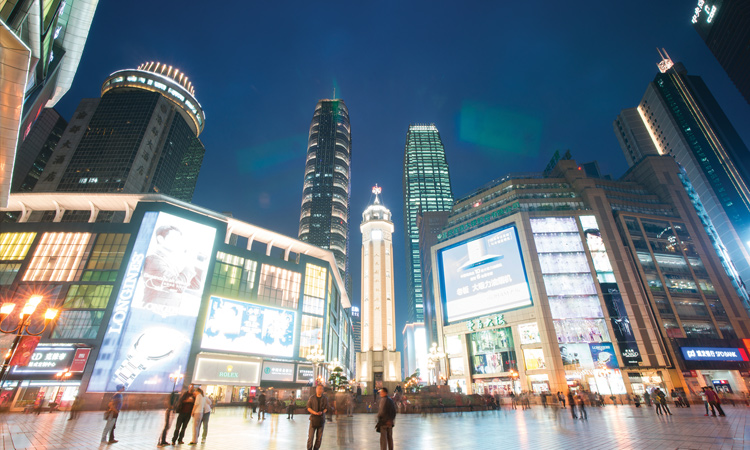 LEDs light up the business center in Chongqing, China. [yangchao / iStock]
LEDs light up the business center in Chongqing, China. [yangchao / iStock]
[Editor’s note: This is the final article in our “OSA Centennial Snapshots” series. The features in this series have highlighted an interesting person, event or trend in optics and photonics during each decade of OSA’s 100-year history. In this closing piece, regular contributor Patricia Daukantas takes us up to the present day, with the story of the world’s ongoing shift to LED lighting. (See the full series online at www.osa-opn.org/link/snapshots.)]
Halfway through the 21st century’s first decade, “energy-efficient lighting” typically meant putting a curvy compact fluorescent lamp (CFL) into an Edison screw socket. While consumers around the world snapped up the latest high-tech gadgets for work and entertainment, they illuminated their indoor and outdoor spaces with technologies invented between 1876 and 1976.
Born in the 1990s, white LED lights had appeared on the horizon of consumer technology, but in 2006, they were considered too expensive for plain old light bulbs. Today, LED bulbs have dropped drastically in price and grown dramatically in market share. They use 85 percent less energy than comparable incandescent lamps; some are so durable that a bulb installed in an infant’s room could see that child into early adulthood. Their small size makes them perfect for artistic light fixtures, outdoor advertising displays and other types of “light art” never before possible.
The convergence of legal regulations, environmental concerns and technological achievement over the past 10 years brought solid-state lighting into popular consciousness. Although LEDs are important components of other devices, from flat-screen televisions to computer displays to smartphones, this article will focus on the path that light-bulb technology has taken over the past decade. The humble LED, which had long played second fiddle to its cousin the semiconductor laser, has finally become a star of the consumer marketplace. Ten years from now, nine out of ten light bulbs could be LEDs.
Groundwork for the lighting revolution
LEDs would have remained little more than red, yellow and green indicator lights if not for the invention of high-brightness gallium nitride blue LEDs in the early 1990s. Putting a yellow phosphor on top of a blue LED turned it into a white, though slightly bluish, LED. Three Japanese researchers, Isamu Akasaki and Hiroshi Amano of Nagoya University and Shuji Nakamura, then with Nichia Chemical Industries Ltd., did the fundamental work to make this discovery.
With the LED color spectrum complete, some engineers and lighting designers foresaw a wonderful future of solid-state lighting; others thought that the technology was too directional and dim to amount to anything. Writing in Optics & Photonics News in 1999, Hewlett-Packard researcher Robert Fletcher found it “astounding” that the lighting industry was looking to LEDs, with bulb manufacturers beginning to form alliances with semiconductor companies.
The humble LED, which had long played second fiddle to its cousin the semiconductor laser, has finally become a star of the consumer marketplace. Ten years from now, nine out of 10 light bulbs could be LEDs.
In 1999, researchers at Hewlett-Packard and Sandia National Laboratories (USA) called for a national research program on solid-state lighting. They predicted that a wholesale switch to LED lighting would slash the amount of electricity consumed by lighting worldwide by more than 50 percent—and would cut the total worldwide consumption of electricity by more than 10 percent.
As far as the public was concerned, though, LEDs were expensive. In 1999, incandescent bulbs produced about 1,000 lumens per U.S. dollar, whereas LEDs could provide only 1 to 10 lumens for the same dollar. The cost of LED lighting is directly proportional to its luminous flux, Fletcher wrote, whereas the manufacturing costs of a 100-W and a 40-W incandescent bulb were virtually identical. In 2008, an LED lamp equivalent to a 60-W incandescent bulb cost roughly US$100. To improve the flux-to-dollar ratio, manufacturers would have to lower the cost of making LED lamps and assemblies, and wring more photons out of the semiconductor materials.
Beating the cost-scaling problem was only one of the issues that lighting manufacturers needed to sort out before introducing LED bulbs to the marketplace. Standardizing bulb sizes, developing specifications that made sense, labeling and marketing bulbs so that the consumer could understand—someone had to figure that all out.
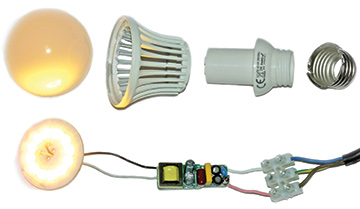 A disassembled LED lamp showing the emitting material, dispersive cover, driver circuit board and Edison screw. [Dmitry G./Wikimedia Commons]
A disassembled LED lamp showing the emitting material, dispersive cover, driver circuit board and Edison screw. [Dmitry G./Wikimedia Commons]
In the early 2000s, when white LEDs were just emerging from the laboratory, their lifetime was claimed to be on the order of 100,000 hours—yet the devices were giving off 50 percent less light after half that time, said Nadarajah Narendran, research director at Rensselaer Polytechnic Institute’s Lighting Research Center (USA). What was behind the wild overestimation?
Narendran and his colleagues realized that the industry-standard lifetime of mean time between failures was appropriate for incandescent bulbs that burn out suddenly, but might not be a useful metric for solid-state lighting. “The failure mode we saw was, the light output was slowly degrading,” he says. Thus, the useful lifetime of a bulb had to be redefined.
Working with an industry alliance, the researchers developed LED lifetime standards: such lighting had reached the end of its useful life when it had experienced a 30 percent drop in initial lumen output for general lighting and a 50 percent drop in initial lumen output for decorative lighting (which is designed to be dimmer anyway). Narendran and his colleagues also discovered how sensitive LED performance is to high junction temperatures; this research helps manufacturers design LED packaging to manage heat within the bulbs.
In 2006, the Pacific Northwest National Laboratory (PNNL) of the U.S. Department of Energy (DOE) produced a report on the lessons learned from marketing CFLs to Americans and how these lessons could be applied to LED technology. PNNL researchers interviewed product and marketing managers at four major lighting manufacturers. The manufacturers stated that they thought that LEDs were definitely a niche product “with applications limited to specialty uses” and that it might be 10 years before LEDs were ready for lighting applications. The study also found that negative experiences with early-generation CFL bulbs led consumers to distrust the technology in the future. Ultimately, the report stressed that manufacturers must educate both retailers and consumers on new lighting technology.
Legal requirements
Over the past decade, the looming specter of anthropogenic global warming has spurred governments around the world to try to force lighting manufacturers to make their products use less electricity.
On 19 December 2007, U.S. President George W. Bush signed the Energy Independence and Security Act of 2007, which effectively set in motion the nationwide phasing out of many common incandescent bulbs. Contrary to the rhetoric from some opponents, the legislation did not “ban” incandescent bulbs—it remains legal for Americans to own them. Rather, the 2007 law mandated that bulbs manufactured after a certain date had to be up to 30 percent more energy-efficient than their predecessors were. Ultimately, the laws of physics dictated that the post-deadline bulbs had to be CFLs or LEDs.
The U.S. law first hit 100-W light bulbs—the “general service” lamps producing 1490 to 2600 lumens. Bulbs of this brightness manufactured after 1 January 2012 could use no more than 72 W of energy. Over the following two years, the 75-W, 60-W and 40-W light bulbs had to meet similar energy budgets. (The U.S. state of California, where about 12 percent of Americans live, chose to implement the standards one year earlier.)
Likewise, members of the European Union (EU), as well as Norway and Switzerland, set a timetable for phasing out most 60- to 100-W incandescent bulbs between 2009 and 2012. India, Australia, China, Japan, Russia and several South American countries have implemented similar policies over the past decade.
The phase-out of higher-wattage incandescent bulbs evoked confusion and grumbling on both sides of the Atlantic Ocean. Some German consumers stockpiled incandescent bulbs shortly before the EU efficiency regulations on 100-W bulbs went into effect in September 2009, and a member of the German parliament called the rules “light bulb socialism.” In 2011, Republicans in the U.S. House of Representatives tried to repeal the 2007 lighting-efficiency regulations, but the measure failed to pass.
In addition, some consumers complained that the quality and color of CFL lamps gave them headaches, that the lamps flickered like older fluorescent tubes, and that the twisty bulbs’ mercury content posed a disposal hazard. Everyone had to start shopping for bulbs by metrics such as lumens, although many manufacturers helpfully labeled the new bulbs with “equivalent wattage.”
LED firsts and technology milestones
In 2006, researchers giving an OSA-sponsored talk about solid-state lighting to U.S. congressional representatives noted the high upfront cost of LEDs. Despite the price tag, a string of “firsts” for LED lighting emerged. For the 2007 season, the famous Rockefeller Center Christmas tree in New York, N.Y., USA, was switched to LEDs for illumination. The following year, the crystal ball dropped in the city’s Times Square on New Year’s Eve underwent the same change.
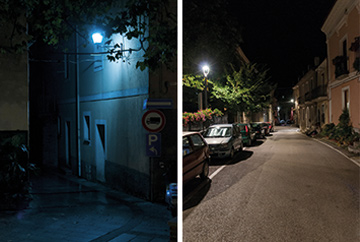 In 2007, the village of Torraca, Italy, converted its entire streetlight system from traditional lighting to LEDs. In 2014, the town installed new Osram Oslon Square programmable LEDs that automatically dim light brightness from 100 to 70 percent after midnight, increasing cost savings, as well as reducing light pollution. (Left) Torraca with traditional lighting and (right) with its new LED lighting. [Osram Opto Semiconductors]
In 2007, the village of Torraca, Italy, converted its entire streetlight system from traditional lighting to LEDs. In 2014, the town installed new Osram Oslon Square programmable LEDs that automatically dim light brightness from 100 to 70 percent after midnight, increasing cost savings, as well as reducing light pollution. (Left) Torraca with traditional lighting and (right) with its new LED lighting. [Osram Opto Semiconductors]
In 2007, the Italian village of Torraca became the first township to convert its entire streetlight system to LEDs. As The Economist reported at the time, an Italian startup manufacturer of electronic automotive parts installed the lights for the community; the magazine called it “a beacon for the new wave of ‘clean-tech’ innovation that is attracting investors just as early computers did a generation ago.” The magazine also predicted that Torraca would go down in history as surely as the Holborn Viaduct, a 19th-century London overpass that Thomas Edison’s incandescent lamps lit from 1882 to 1884 as a proof-of-concept experiment.
Automobile manufacturers started using red LEDs for the center high-mount stoplight—the “third brake light” required by U.S. law—in the late 1990s. As scientists improved the brightness of LEDs—both red and white—the technology spread to other parts of the vehicle lighting system. In 2008, Audi became the first manufacturer to put all-LED headlamps on a car. Today, if your car does not arrive with solid-state lights, you can easily find some aftermarket lamps and fixtures for it.
Also in 2008, Ushio Lighting demonstrated the first so-called “LED filament” light bulb—a lamp with long, thin LED emitters arranged to resemble an old-fashioned incandescent filament, usually encased in a clear glass bulb. Filament lamps are not as long-lived as other LED lamps, but they still save energy while giving restaurants and homes a warm “vintage” look.
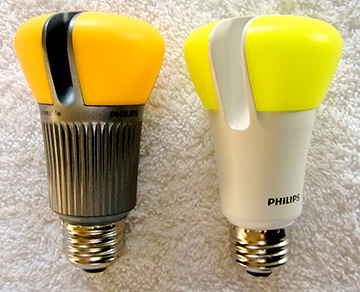 The Philips bulb that won the U.S. Department of Energy’s L Prize (right), next to one of the winner's technological precursors (left). [Geoffrey A. Landis]
The Philips bulb that won the U.S. Department of Energy’s L Prize (right), next to one of the winner's technological precursors (left). [Geoffrey A. Landis]
In the spirit of the Orteig Prize, which spurred great advancements in aviation during the 1920s, and the Ansari X Prize, which jump-started the private spacecraft industry, DOE unveiled the Bright Tomorrow Lighting Prize (better known as the L Prize) competitions in 2008, to encourage the improvement of solid-state lighting products. Two contests were set up: one to replace the familiar standard 60-W incandescent bulb and another to supersede the PAR 38, a parabolic aluminized reflector lamp widely used in recessed light fixtures and stage lighting.
Both competitions listed various requirements for the winners in terms of luminous flux, lumens per watt, longevity, color temperature and, of course, energy consumption. Philips Lighting won the 60-W replacement competition in 2011 with a 10-W bulb with both red and blue LEDs exciting yellow phosphors. The lamp emitted 940 lumens when new and maintained 97 percent of that flux after 25,000 hours.
The company’s 2011 annual report claimed that if every 60-W incandescent bulb in the United States were replaced with its prize-winning model, the country would save $3.9 billion in one year and reduce its carbon emissions by 20 million tons. Philips briefly sold its prizewinner in the United States but soon took it off the market.
In 2014, DOE suspended the PAR 38 competition because none of the LED replacement bulbs on the market came close to the contest’s tough specifications. For example, one 90-W-equivalent LED PAR 38 advertised for sale in 2016 offers 69 lm/W with a color rendering index (CRI) of 80, while the competition required 123 lm/W and a CRI of 90.
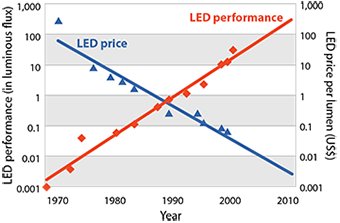 A “Moore’s Law” for LEDs?
A “Moore’s Law” for LEDs?
Computer scientists are familiar with an observation made by Intel Corp. co-founder Gordon Moore that notes that the number of transistors on an integrated circuit doubles every two years. Does a similar rule hold for a different kind of semiconductor chip—the light-emitting diode?
Roland Haitz (1935-2015) thought so. A longtime researcher at Hewlett-Packard and Agilent Technologies, he was co-author of a 1999 Optoelectronics Industry Development Association report that, at a conference in 2000, projected that the amount of light generated from LEDs would increase by a factor of 20 per decade—accompanied by a factor-of-10 decrease in cost per lumen over the same period. Haitz also predicted that the industry would reach the efficiency benchmark of 200 lumens per watt by 2020. As it had done for Moore’s Law, the optimization of the semiconductor-manufacturing process would drive these changes.
Accumulated data over the past decade and a half have generally borne out “Haitz’s law.” The L Prize-winning bulb emitted 94 lumens per watt, and manufacturer Cree Inc. claimed that it had broken 100 lm/W in 2010. Today, a quick online search for 60- and 100-W equivalent LED bulbs finds many in the approximate 100 lm/W range.
2014 to the present
By the start of 2014, U.S. companies had stopped producing all common 40-W, 60-W, 75-W and 100-W incandescent bulbs. (Specialized incandescent bulbs, such as those designed for appliance interiors and decorative fixtures, are still being manufactured; the 2007 U.S. law, like its equivalents in other countries, does not apply to them.) In its 2015-2016 catalog, the international home-furnishings giant Ikea announced that it would sell only LED bulbs from then on. Earlier this year, no less an iconic brand than General Electric, associated with the light bulb for more than a century, announced it would end production of CFLs in favor of solid-state lighting. Thomas Edison himself would have been astonished.
Today, U.S. consumer publications run articles with headlines such as “6 Reasons to Switch Every Light Bulb in Your House to LED.” A recent Goldman Sachs report predicted that by 2020, six out of ten light bulbs will be LEDs—and nine out of ten bulbs by 2025. Akasaki, Amano and Nakamura equally shared the 2014 Nobel Prize in Physics for their contributions to the invention of blue LEDs and, by extension, the bright white LED. It’s not every year that the Nobel committee singles out a tangible, easily understood product that fits in the palm of one’s hand.
Still, despite its legal favor, energy efficiency and overall popularity, some concerns about LED lighting remains, says OSA Fellow John M. Dudley of the Université de Franche-Comté (France), the leader of the International Year of Light (IYL) 2015 celebration. For example, the color temperature of many white LEDs is higher (bluer) than that of other artificial light sources, which some researchers say could interfere with human sleep patterns by suppressing the secretion of the hormone melatonin.
Nevertheless, it is safe to say that LEDs are here to stay. Not only is solid-state lighting 85 percent more efficient than incandescent bulbs, it is 40 percent more efficient than fluorescent tubes. Goldman Sachs predicted that those figures might rise to 95 percent and 50 percent by 2020. This makes it no wonder that LEDs are already at a 28 percent market share and climbing steadily. CFLs may turn out to be an interim technology between the world of Thomas Edison and the world of tiny semiconductors.
But could the very durability of solid-state lighting ruin the industry when market saturation hits and consumers no longer need to buy replacement LED bulbs? After all, if a bulb that is claimed to last 25,000 hours is switched on for three hours a day, it will remain in service for almost 23 years.
A recent article in The New Yorker (14 July 2016) traces the history of “planned obsolescence” as developed by a cartel of incandescent bulb manufacturers in the early 20th century. Since industry analysts are predicting that the LED-bulb market could reach “socket saturation” by the end of this decade, some manufacturers are introducing cheaper bulbs with shorter life spans. (The promised life spans cannot be too short, however; California, for example, will mandate a 10,000-hour life span starting in 2018.)
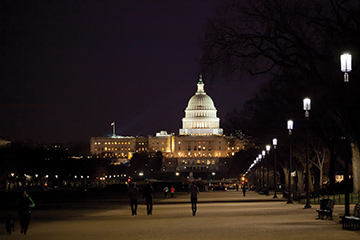 LED lights were first installed along the National Mall in Washington, D.C. in January 2012. [Quentin Kruger/U.S. Department of Energy]
LED lights were first installed along the National Mall in Washington, D.C. in January 2012. [Quentin Kruger/U.S. Department of Energy]
Optics: Lighting the way to the future
The solid-state lighting revolution is but the latest chapter in a story that took optical science from a niche field of eyeglasses and telescopes to an integral part of society’s technological fabric. Along the way, trends bubbled up from the research lab to the public, faded from view, and later resurfaced in new ways. For instance, polarization filters failed to gain traction with the automobile industry but made smartphones possible. Widescreen and 3-D movies of the early 1950s presaged high-definition television and virtual reality. Optics went to war, and lasers bounced off the Moon during humanity’s era of lunar exploration.
Dudley says low-energy LED lighting is a key component of humanitarian efforts such as the Power to All initiative, which seeks to bring off-grid electricity and interior lighting to the underdeveloped world by 2030. Groups such as Sunny Money of Kenya have been selling all-in-one units for micro-entrepreneurship: these appliances harvest solar energy during the day and provide LED light and phone-charging capacity at night. “They’re not charitable giveaways; they’re long-lasting units that someone in a village could purchase and then charge the neighbors small amounts of money to charge their devices,” Dudley says.
During IYL 2015, the LED revolution gave Dudley fresh insight into light’s essential role in education and democracy. Children who do not have lighting in their homes cannot read books and share them with their friends, and thus cannot receive perspectives that differ from those of authority figures such as teachers or parents.
“How is it any surprise to us that there are whole generations that follow false ideologies without question?” Dudley says. “The simple installation of lighting in people’s homes is something which I think is essential—it’s as essential to the practical diffusion of intellect as the printing press was.”
Patricia Daukantas is a freelance writer specializing in optics and photonics.
References and Resources
-
R. Fletcher. “High efficiency LEDs: A bright new light source joins the lighting industry,” Opt. Photon. News 10(4), 18 (April 1999).
-
P. Daukantas. “Making the case for solid-state lighting,” Opt. Photon. News 17(9), 8 (September 2006).
-
Pacific Northwest National Laboratory. “Compact fluorescent lighting in America: Lessons learned on the way to market” (2006).
-
P. Daukantas. “50 years of visible LEDs,” Opt. Photon. News 23(11), 32 (November 2012).
-
J.Y. Tsao. “Roland Haitz: Twenty years of mentorship, collaboration and inspiration,” Sandia National Laboratories (2015).
-
Goldman Sachs Research. “The low-carbon economy” (30 November 2015).
